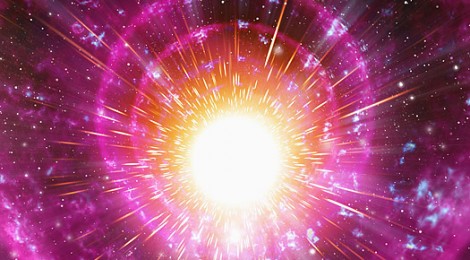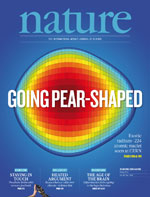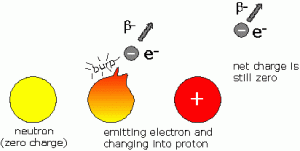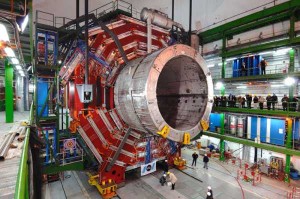
Big Bang Mystery Of Missing Dark Matter Explained? Has It Been Right Here With Us Forever.
There is a great mystery and problem in the Big Bang model for the creation of everything
In the moment of creation the theorists propose that an equal amount of normal matter and other matter, anti-matter was created.
The science community believes it has measured the amount of normal matter but it cannot find an equivalent or even greater amount of other matter. A lot of something is missing. There are gravitational measurements that suggest the other matter is in the universe but it cannot be directly observed. Missing unknown matter that ought to have resulted from a balanced Big Bang, is called ‘dark matter’ simply because it is unseeable and thus unknown.
The great problem in the quest for dark matter is that of our insufficient tools and methods to observe both normal matter and “other matter.” It is as if we were scientists with all of the expertise and tools needed to study and measure a forest only are suddenly tasked with studying and measuring microscopic aquatic plankton. We might be sure the plankton exists but we could not possibly describe it with just a set of forest tools. In new explorations of unfamiliar ecologies, including the atom-ecologies, we need new tools.
This may really be a problem in the dogmatic psyche of those studying the problem and their very human natural desire to stay inside the box of what they think is the known. In most fields of science one much more rarely makes great discoveries by staying inside the comfort of the box. True pioneer scientists have always been seen to be those who ventured outside into the world of the unknown, unfamiliar, even unimagined. Pioneers are incredibly rare.
 Recent reports of pear shaped nuclei suggest that the nucleons inside atom nuclei are not behaving as perfect spheres and clustering themselves in unexplainable ways and shapes. This allows for some interesting ideas on the ecology of atoms and their nucleons. What other strange, unfamiliar, and unimagined characteristics might be found inside the domains where atoms reside, or might/must be found inside the atom itself. How might we account for the nucleon clusters that produce differently shaped atomic fruit. Here’s a hint, nucleon clusters have a great deal to teach about the role of beta electrons or vice versa.
Recent reports of pear shaped nuclei suggest that the nucleons inside atom nuclei are not behaving as perfect spheres and clustering themselves in unexplainable ways and shapes. This allows for some interesting ideas on the ecology of atoms and their nucleons. What other strange, unfamiliar, and unimagined characteristics might be found inside the domains where atoms reside, or might/must be found inside the atom itself. How might we account for the nucleon clusters that produce differently shaped atomic fruit. Here’s a hint, nucleon clusters have a great deal to teach about the role of beta electrons or vice versa.
Naturally what we might learn about the inside of an atom is very much defined by what our tools allow us to see and measure. Herein lies a classic conundrum of all pioneering science. Pioneers almost always have to see or sense some hint of something before they can invent the tools to see and measure the previously unknown.
Arrows flying
This is where pioneers in science inevitably find they are alone and worse. Many tales and admonitions warn people of scientist of the consequence of being a pioneer, my personal favourite is “pioneers find more arrows in their backs than in their fronts!” So here is your chance, all you who think quark bag models and nucleon cluster models are heresy, here’s my back, fire away.
So it has seemed to me ever since I saw some tantalizing data in experiments starting more than 20 years ago that I could not explain. Using normal models for the atom the data speaking to me suggested surely the models were just a bit out of kilter. I desperately needed some asymmetry inside the nuclei of atoms. I was led by a friend, Dick Taylor (Nobel laureate for the Quark) and other colleagues with lifetimes of work in atomic physics to look at quark bag and nucleon cluster models and therein lies a tale to tell.
The key with modern models for the atom is that they depend on the tools and methods to study the inside of the atom that we have had at hand. These tools are all hammer like. We break atoms apart with great amounts of energy and study the pieces. They are tools where we turn atoms and bits of atoms into the state of matter called a plasma and energetic penetrating radiations.
This is a high energy environment where the pieces are few and far between but when they interact with something the effect is observable. And we keep making better and better and bigger and bigger detectors to observe the fragments that result from ever more energetic hammer blows to break things apart. It’s all good stuff to further refine the known.
But this house of plasma is just not Natures normal native state for we people and other bits that like to think we make up Nature.
Natures native state for all that we know as atoms and parts of atoms is a cool, aka room temperature, stable condensed matter state. This is the universe we live in and much of physics, almost all of chemistry, and perhaps most of biology, live in the cool and calm. So might Nature have some hidden mysteries she’s not shared with us in this realm. I like to think so. Especially since almost all of our tools and history of study in this realm have been so un-cool and energetic. Sometimes less is more.
What’s Missing
Back to the dilemma of the Big Bang. Where is the missing other “dark” matter? What is the missing unknown matter? How might we find it? How might we know what it might look like?
What if the missing matter is just so very different than normal matter that we can’t see it with our usual tools and methods. Perhaps it is hiding in plain sight.
What we like to say we know in Big Bang theory is that moments after the bang as energy condensed into “stuff”. It should all be accounted for as “stuff.” Much of it is, about half. It is almost all accounted for in the ecology of atoms, inside the nuclei of atoms, there are protons and neutrons, that was easy.
 Protons and neutrons are almost the same thing, indeed when a neutron which is just a little different is out of the company of a proton it turns promptly into a proton.
Protons and neutrons are almost the same thing, indeed when a neutron which is just a little different is out of the company of a proton it turns promptly into a proton.
It’s rather like many of my scientist geeky friends, they are not the same without the stabilising company of their mates.
So when the missing stuff of the Big Bang’s energy condensation stage could not be seen, measured, or found, the scientists of the day, even this day, decided it must be exotic stuff and be off gallivanting about the universe just like the normal matter and we just haven’t figured out where it is, what it is, and how to see and measure it.
But what if in the moment of condensation the “other matter” which is very very different from normal matter just condensed right along side the normal matter and lies inside the nuclei of atoms. It is so very different than normal matter we still can’t see it there and our tools to detect fragments of normal matter that we’ve energized with our plasma experiments simply cannot see the other matter.
But from an ecologists point of view I find it is far more likely that other “aka dark” matter and normal matter are more similar than we might think and in fact do co-habitate inside the nuclei of atoms. That’s a very low energy world of cold condensed matter where momentum is at a minimum, there is ample space, and nuance rules. It is easier to assume that given the assumed uniform conditions of the Big Bang that half or more of everything didn’t mysteriously go wildly off on its own. In fact all that we know says everything behaved how and ended up where we expected.
We know that inside atomic nuclei there are all manner of forces like the strong force and the weak force, quarks of many colours, and lots and lots of strange bits and pieces. A famous particle physicist on being asked if he could name all of the strange particles inside his world said, “No if I could do that I would have become a botanist.” All those forces and bits rule the ecology of the atom but when violations of those rules appear such as pear shaped nuclei one ought to call for a full stop and start looking at that entirely new flavour and characteristic of what is going on in that newly discovered fruit.
Enter the present reality of unexpected and unexplained observations that after 20+ years are becoming more and more easily reproduced. Common Cold fusion and LENR effects and a raft of other more obscure effects suggest that when we observe the behaviour of atoms and their ecology in an environment almost totally the opposite of our favoured plasma environment we see new phenomena. This new world is the world of super dense super low energy solid state atom environments.
Take for example when one has a large metal lattice made up of nickel or palladium or many other hydrogen loving metals. One can if one is skilled in the art slowly and gently push the tiny hydrogen nuclei into the spaces in between the large metal atoms.
This works with hydrogen as it has just one electron and that single electron is perfectly happy to go visit with some other big nuclei full of its beloved protons, leaving the hydrogen nuclei behind a shrunken tiny bit of its normal self. In fact the numbers of hydrogen nuclei that one can get into the metal lattice spaces can raise the density (fugacity) of the hydrogen to a density greater than that of metallic hydrogen, densities of matter like those inside the hearts of stars but stone cold. Now that is a very different environment and we would expect different ecologies of behaviour to be found there.
And that is exactly what we find. We see nuclear reactions that change one atom into a different one. And this takes place without the accompanying energetic emissions of energy balancing radiations that are requisite in higher energy environments and atomic ecologies. We know the radiations are missing because radiation is very very very easy to see and measure. We can see a extra single radiation emission over the course of days. But reaction products in the form of new nuclei suggest reaction rates at e12/sec and more. These are fantastic clues but we don’t yet have the theoretical tools to fully explain them.
What might allow for such reactions? Perhaps since every thing is so tightly jammed together barriers that seem to be perfectly behaved and understood in high energy environments do not act the same in super dense cold environments.
Is other matter, unmatter, dark matter inside nuclei changing the way nucleons inside atoms behave? That’s a good question and one that has been kicking around for decades. Something very dramatically different from what many have thought to be well understood is taking place amongst the atoms that are engaged in cold fusion and cold transmutation effects seen in such experiments. Pear shaped nuclei command some unknown mysteries be in play.
Perhaps this is where a different form of matter, almost utterly different from normal matter but not quite, might interact with that normal matter. Perhaps all the normal geeky matter cohabitating with all that very different dark matter for billions of years has resulted in the two might come to agreement on how to procreate.
OK so all this might not be so easily explained but for certain there are some fantastic new tools and methods for observing the ecology of the atom in ways almost no one has considered.
Isn’t letting the data speak, what science is all about.
Science is not about rejecting all data that does not conform to the winners of the popularity theory contest.
Here’s a pdf of a paper about how nucleon clusters in nuclei change our view of the atom. NucleonCluster_paper_PP-04-03
Soon I hope to be back at the lab bench building the tools needed to discover some of the mysteries of this vast atom-ecology that we are a part of.

